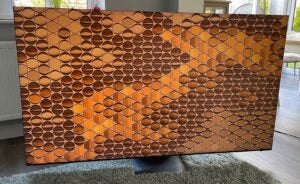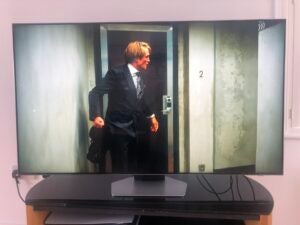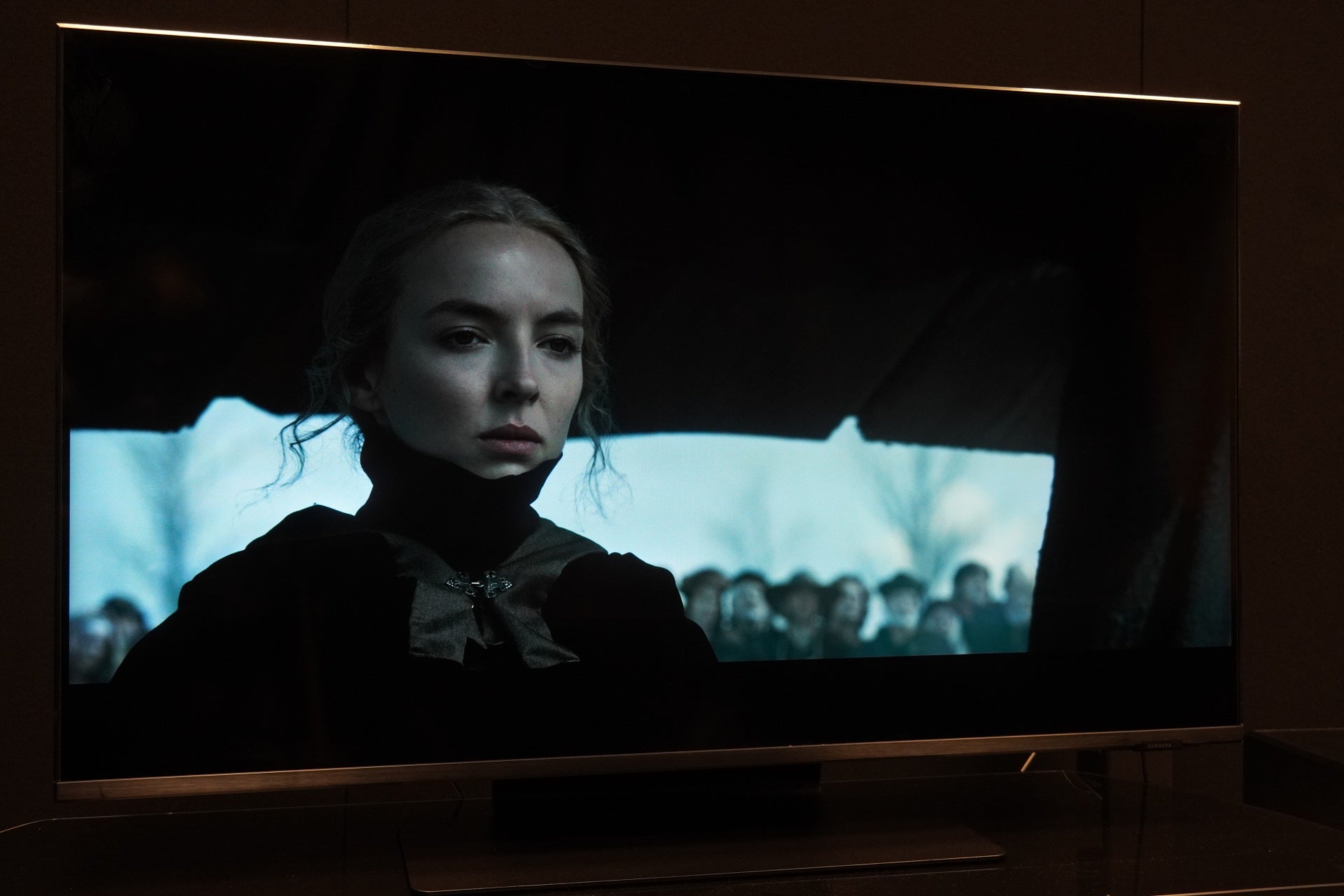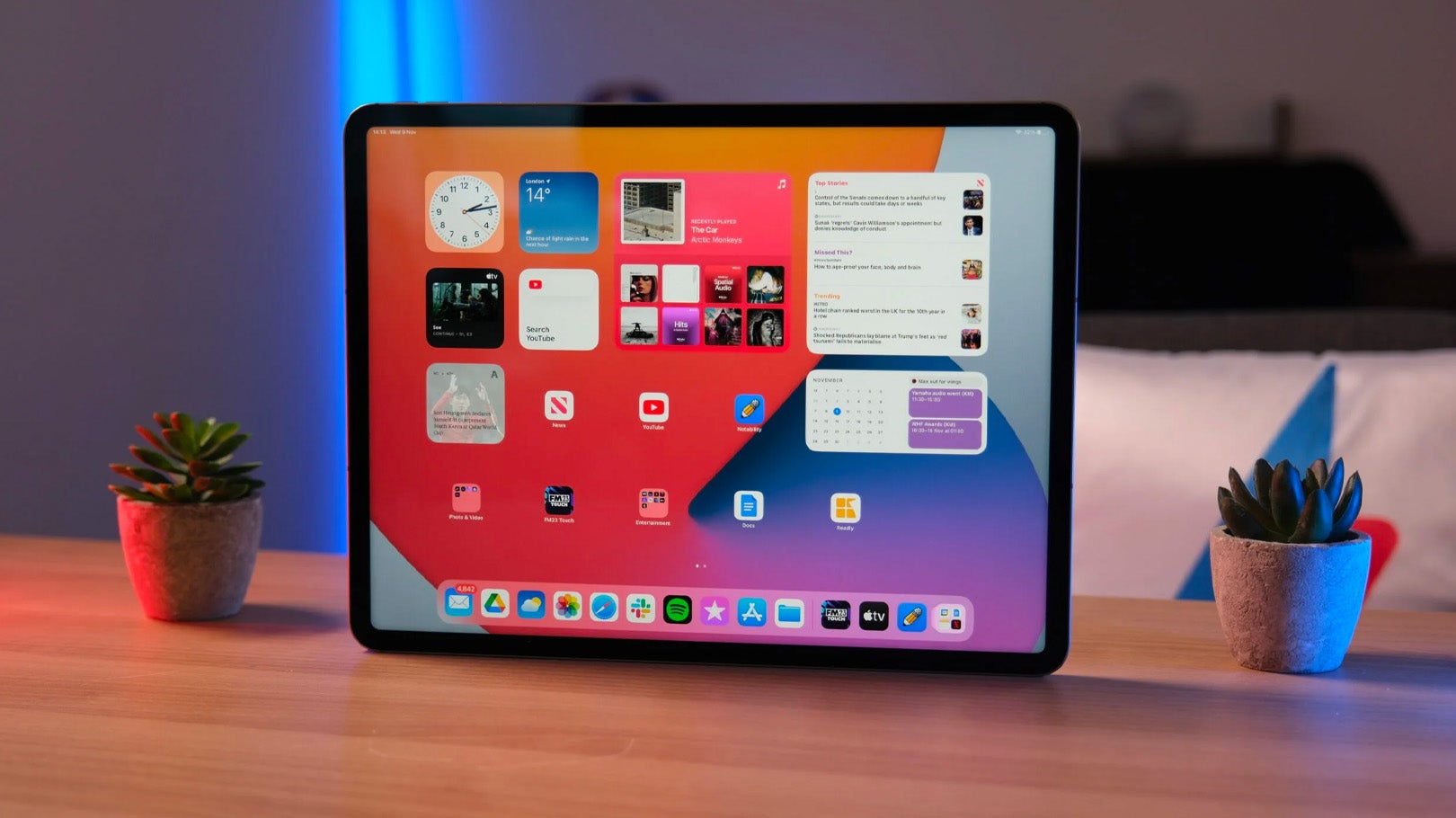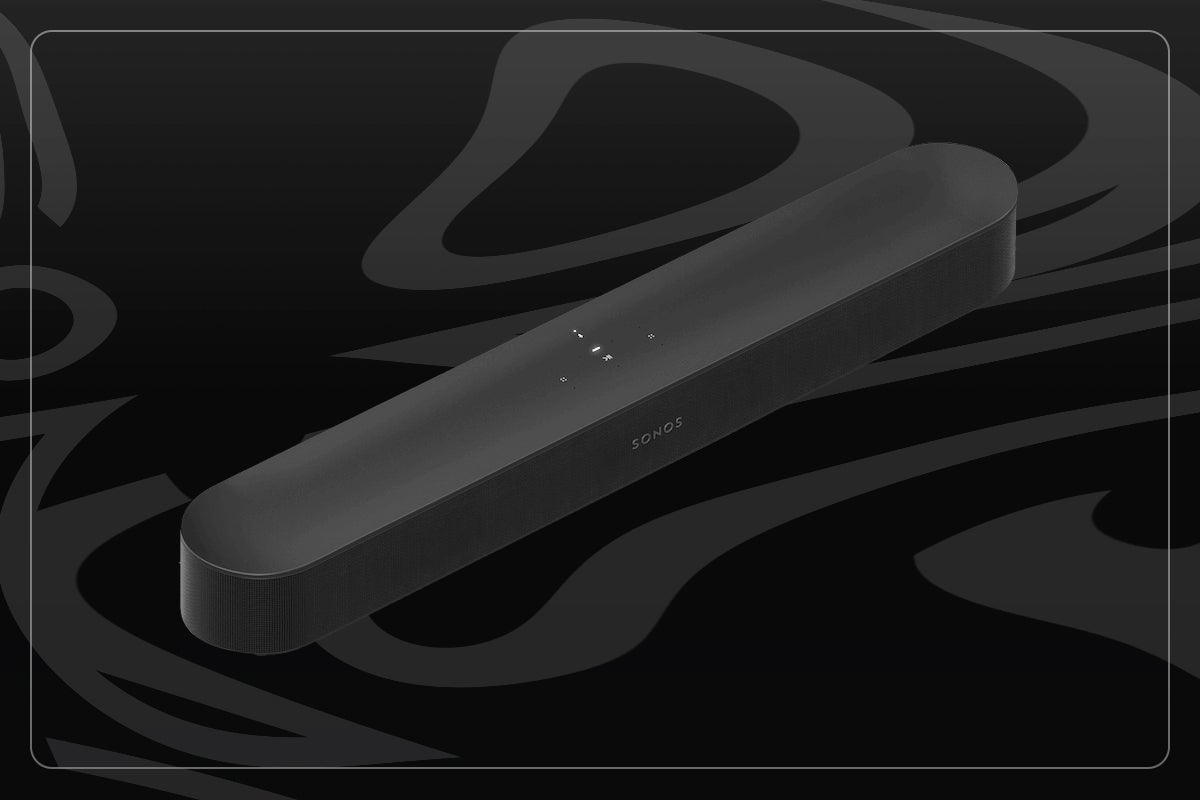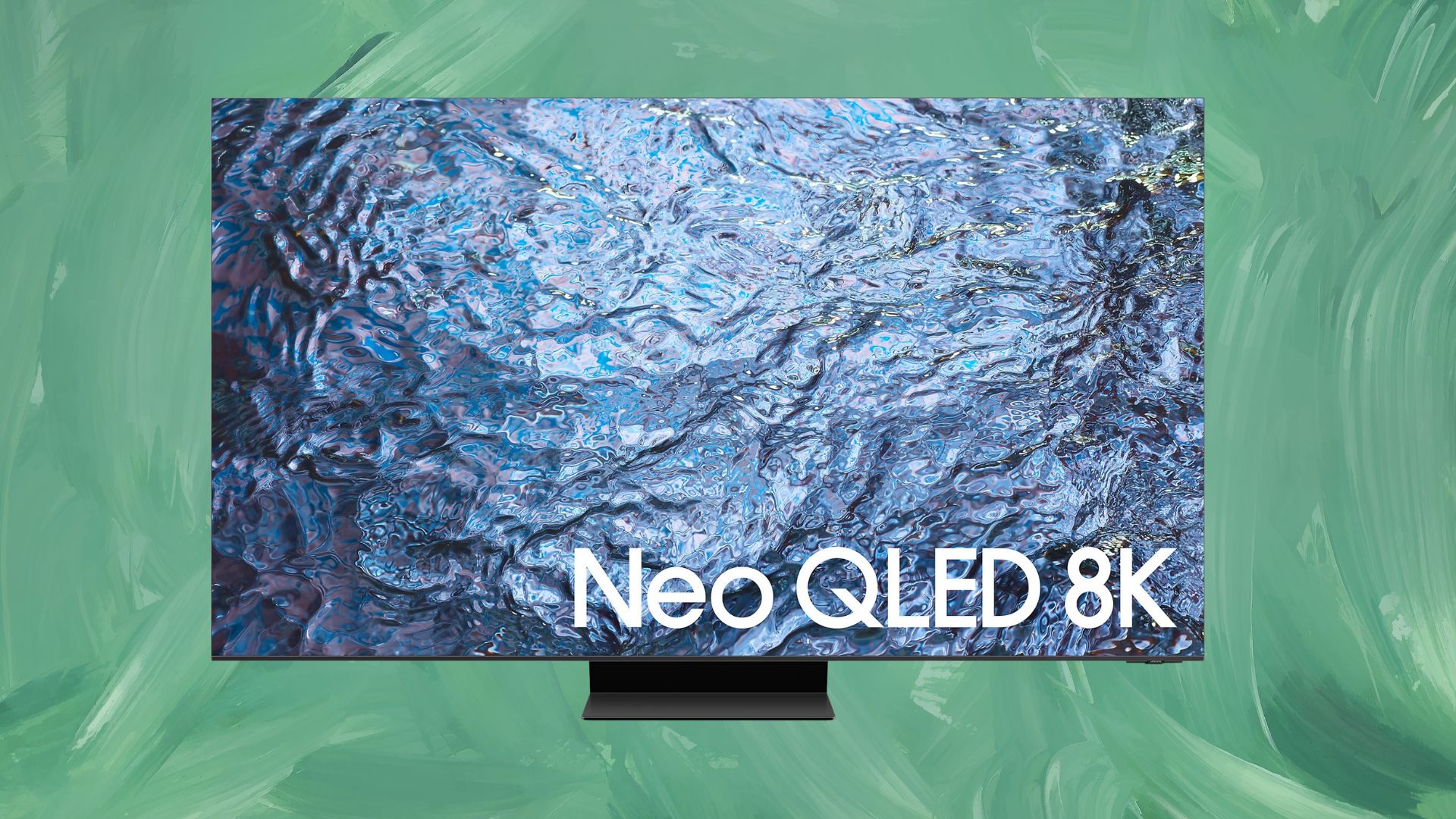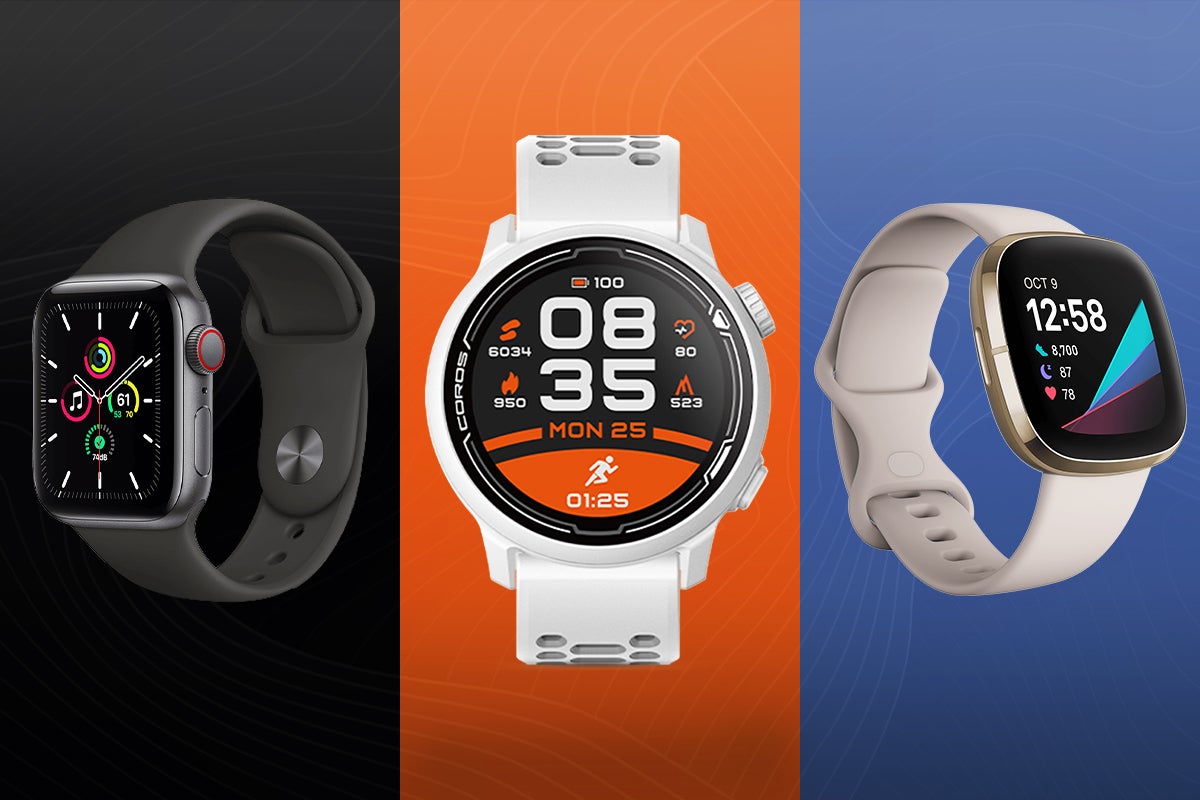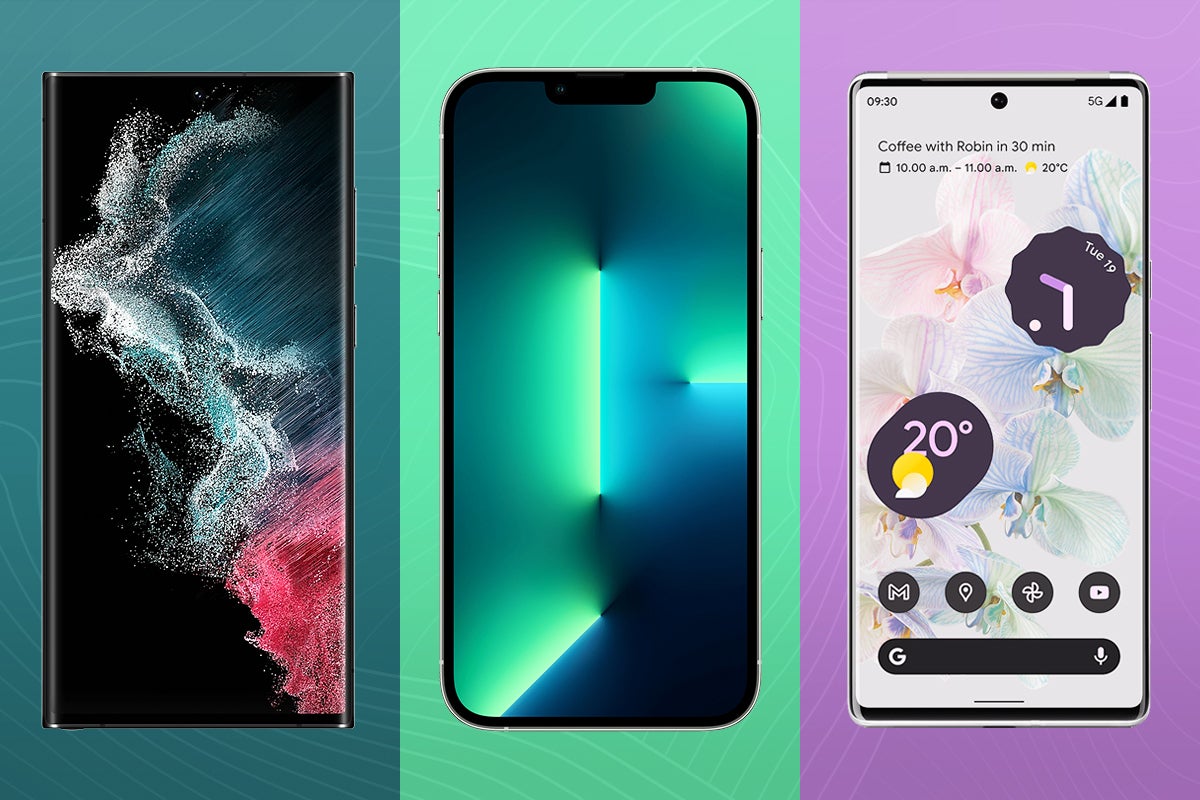Best Samsung TV 2024: From budget 4K sets to 8K QLEDs
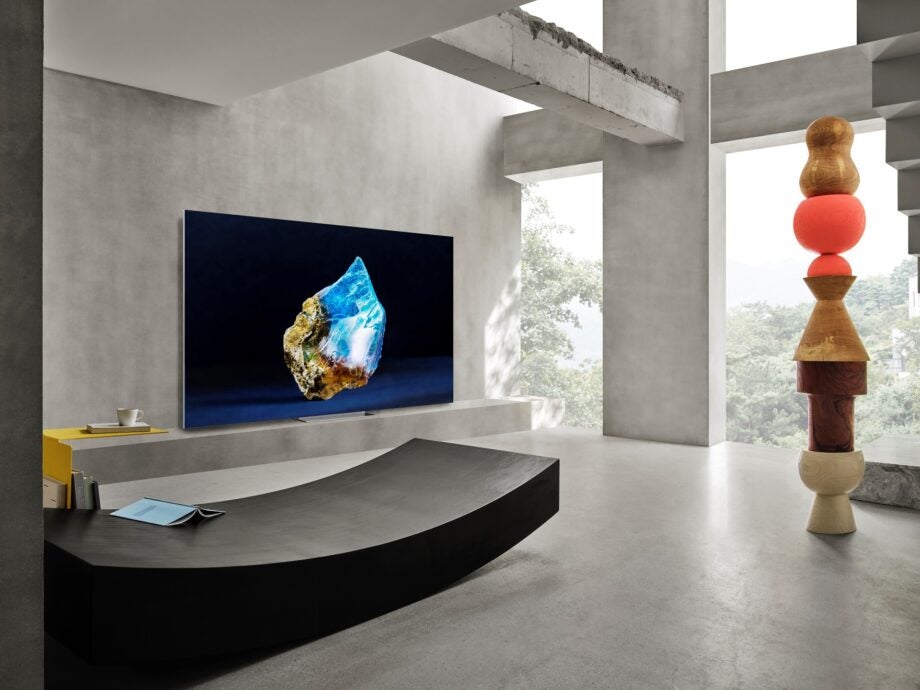
Samsung is a big believer in making TVs for everyone, and in 2024, you’ve got plenty of televisions to choose from.
We’ve tested TVs as small as 43-inches to as large as a 75-inch 8K TVs, but you still need to know which one suits your needs best. This is where our team of product experts can point you in the direction of a new TV as they’ve tested a wide range of Samsung’s TVs .
We review each TV extensively over several days to gauge their performance, as well as appraise their respective feature sets, using tests to measure their performance and offer up as a benchmark to help compare to others TVs.
We focus on areas such as picture quality, how good its built-in speakers sounds, the quality of its construction, and how easy its interface is to navigate, as well as thinking about who the audience for the TV is, and from there we’ll come up with an assessment of how good the TV is and whether it’s good enough to be recommended.
We’ll be updating this page throughout the year as we review more and more sets from Samsung. However, if a TV from Samsung doesn’t tickle your fancy, be sure to check our lists of the best LG TVs, as well as the best Panasonic TVs and selection of the best TVs in general.
Best Samsung TV at a glance
- Best Samsung 8K TV: Samsung QN900B – check price
- Best Samsung 4K TV: Samsung QN95C – check price
- Best Samsung OLED TV: Samsung S95B – check price
- Best budget Samsung TV: Samsung AU9000 – check price
- Best affordable Samsung Mini LED TV: Samsung QN85B – check price
- Best Samsung lifestyle TV: Samsung The Serif – check price
How we test
Every TV we review is put through the same set of tests to gauge its picture performance, usability, and smart features.
Tests are carried out over several days and are done by eye but supported with technical measurements. Testing by eye involves an expert watching a wide range of material to understand and determine a TV’s performance in fields such as brightness, contrast, motion processing, colour handling and screen uniformity.
We’ll consider the design of the TV in terms of build quality, study the spec sheets and see if the TV’s connections are up to spec, as well as playing video and audio content to ensure that the set handles playback as it claims. We also take note whether a product’s compatible formats and features are in line with industry trends or not to gauge whether it’s relevant for you.
Comparison to other related and similarly priced products is also important, to see if it’s missing any vital features and whether it impresses as a whole. After all this, we’ll come to a judgement on how the TV performs as a whole.
If you want to learn more, please visit our detailed page about how we test televisions.
- Easy setup
- Solid picture quality
- Amazing value for money
- UI can be a little slow
- Limited connectivity
- Impressive 4K picture quality
- Great user interface
- Elegantly slim chassis
- No Dolby Vision HDR
- Sounds weak and vague
- Upscaling can be exposed on occasion
- Spectacularly bright, colourful pictures
- Gorgeous ‘Infinity’ design
- Peerless LCD light control
- It’s expensive
- Needs good quality sources
- Minor backlight issues
- Impressively slim screen
- Great for gaming
- Expressive and colourful picture performance
- Big, loud audio performance
- Great viewing angles
- No Dolby Vision
- Sluggish smart remote
- Picture settings require tweaking
- Speakers suffer from bass distortion
- Distinctive design
- Colourful picture performance
- Good upscaling
- Solid range of smarts
- Limited HDR performance
- UI can be sluggish
- Not the most practical TV
- Bright, vibrant and (mostly) detailed images
- Good spec for next-gen games consoles
- Neat, slim design
- Struggles to differentiate black tones
- No Dolby Vision HDR (again)
- Smart TV interface has gone backwards
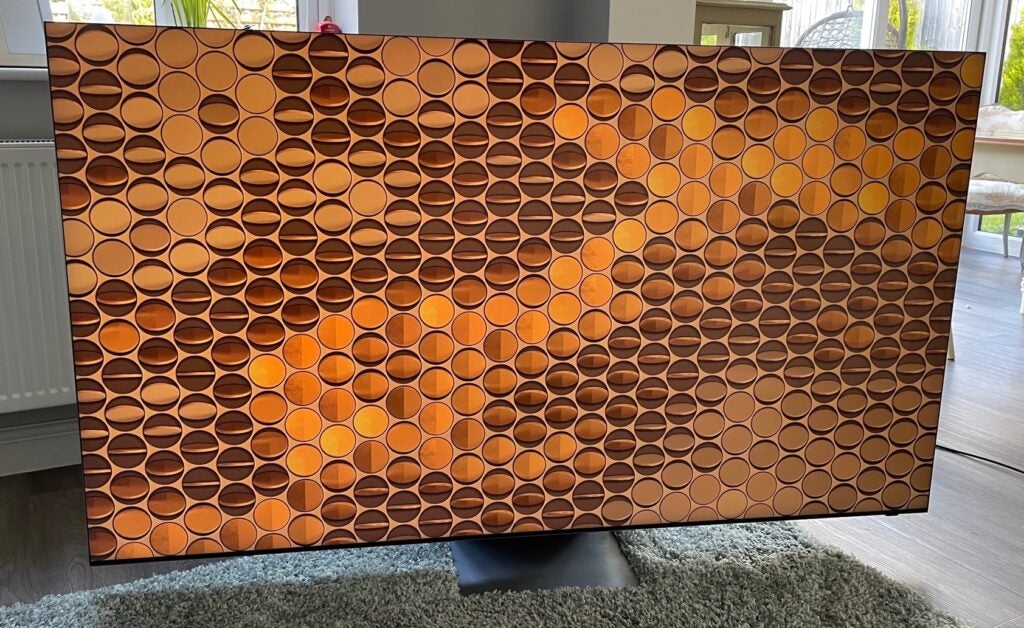
Samsung QE75QN900B
Best Samsung 8K TV
Pros
- Spectacularly bright, colourful pictures
- Gorgeous ‘Infinity’ design
- Peerless LCD light control
Cons
- It’s expensive
- Needs good quality sources
- Minor backlight issues
The QE75QN900B is Samsung’s top-tier 8K TV, and likes its predecessors, it’s a ground-breaking feat of TV technology and the best performance you can get from any LCD screen.
Armed with thousands of nits of brightness, our reviewer found the TV’s high ceiling for brightness produce a fabulous range of colours, in particular reds and greens, delivering bright tones that few TVs can get close to. Black levels surpass that of 75QN900A, and get close to reaching those produced by OLED panels with exceptional consistency and depth. That does come with a caveat as backlight blooming can appear when viewing the TV at wider angles.
Its 8K support make images look immensely clear and sharp with native 8K content (if you can find it), but we found it to be no slouch with upscaling 4K content. The extra colour refinements along with a better sense of texture, depth and detail to an image shows an 8K TV doesn’t necessarily need native 8K content to shine, though the continuing lack of it is not helping matters.
For gamers variable refresh rates, auto low latency mode and High Frame Rate support (4K 120Hz) are all included, and we measured input lag at 9ms, similar to other Samsung TVs and one of lowest levels of latency you can find on any TV. Even though it’s upscaling 4K 120Hz content into 8K, our reviewer did not note any lag, smearing or over-sharpening of effects when playing games or using VRR.
The QN900A’s audio system was one of the better flatscreen efforts on the market, and the 6.2.4 driver set-up produces another similarly good performance, though now it’s aided by Dolby Atmos support.
With speakers firing upwards and to the sides it presents a big sound, but what’s most impressive is how well the TV places sound effects in the right position to match the action both on and off screen. The bank of eight woofers on the TV’s rear produce decent bass without succumbing to distortion, and while it’s perhaps a bit much to ask from a TV, the Samsung doesn’t fire sound into the room towards the listening position. It does reduce the impact of the QN900B’s more immersive skills.
Reviewer: John Archer
Full Review: Samsung QE75QN900B
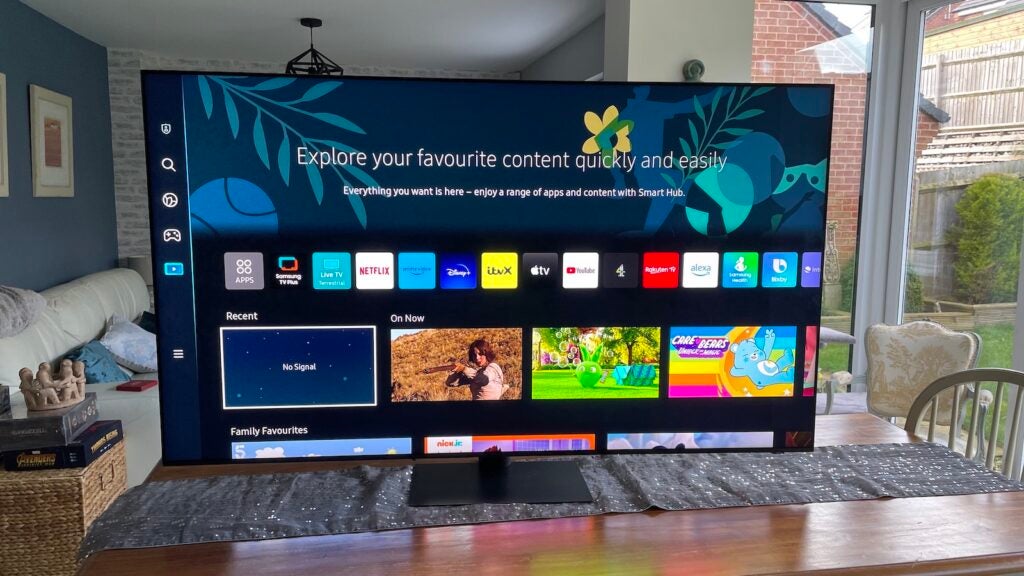
Samsung QE65QN95C
Best Samsung 4K TV
Pros
- Stunningly bright, colourful pictures
- Groundbreaking LCD black levels
- Excellent gaming support and connectivity
Cons
- No Dolby Vision support
- A few backlight niggles
The Samsung QE65QN95C is the brand’s flagship 4K TV, offering an alternative to the next generation of OLED 4K TVs from the likes of LG, Panasonic and Sony.
The picture performance improves on the TVs that come before such as the QN95A and QN95B, with a substantial increase in dimming zones (from 720 to 1344) helping to produce better contrast, black levels and more precision in terms of brightness.
Blooming, which are unwanted halos of light around bright objects, are reduced; and we found that unless you were watching the TV from a very wide and shallow angle that blooming was mostly unnoticeable. That’s an improvement on what we’ve seen from previous Samsung Mini-LED TVs.
Brightness was measured at 2240 nits, which is around the same level of brightness we encountered with the QN95B and easily betters even the brightest OLEDs we’ve tested from competing brands such as the LG G2 and Panasonic LZ2000.
As a gaming television, all four of the HDMI inputs support 4K/144Hz, so gamers don’t have to pick and choose which devices go into which HDMI input. There’s HDMI VRR for gaming consoles, with PC gamers getting AMD FreeSync Premium Pro. Nvidia G-Sync is not officially supported but gamers can still play compatible games with that feature if they choose to do so. We measured input lag to 9.8ms, which is a little faster than the 2022 model.
The speaker system is, in our opinion, a step from what came before, with more power, clarity and scale observed from the QN95C’s 4.2.2 audio system. The Object Tracking Sound (OTS) system plants effects on screen with accuracy, with the TV less prone to buzzing or distortion when having to deal with bassy effects..
Reviewer: John Archer
Full Review: Samsung QE65QN95C
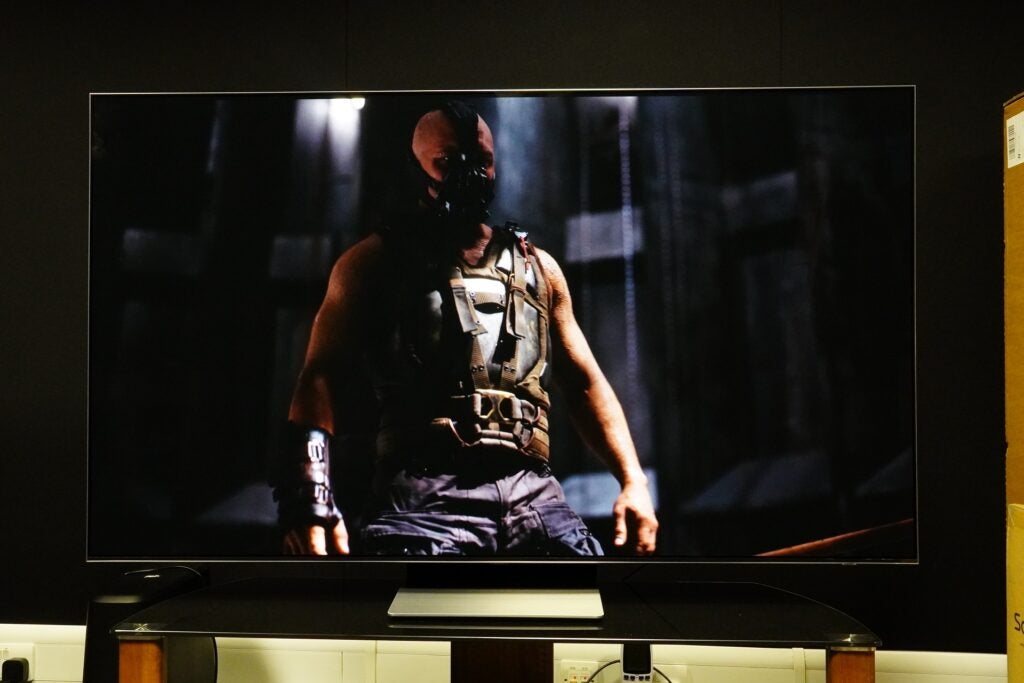
Samsung QE65S95B
Best Samsung OLED TV
Pros
- Impressively slim screen
- Great for gaming
- Expressive and colourful picture performance
- Big, loud audio performance
- Great viewing angles
Cons
- No Dolby Vision
- Sluggish smart remote
- Picture settings require tweaking
- Speakers suffer from bass distortion
After nearly 10 years of ignoring OLED technology, Samsung decided to create its own panel technology in QD-OLED and in the S95B it remedies some of the issues that OLED’s detractors have made a point of constantly repeating.
The main issue is namely brightness. The S95B is a Quantum Dot OLED TV like Sony A95K, though it beats out the A95K to be the brightest QD-OLED we’ve encountered thus far, hitting over 1000 nits in almost all of its picture modes for vibrant, punchy and colourful viewing experience.
However, we’re not too fond of its picture out of the box for some settings. The colour balance, contrast and levels of brightness aren’t always to our liking, requiring some tweaking to get the images up to the standard we like. Once done, the S95B delivers terrific images, but getting there feels like hard work. All the streaming video apps you could want are included, but Samsung’s steadfast refusal to support Dolby Vision still annoys.
Like the rest of Samsung’s TV output, the S95B is great at upscaling lower-than-4K content, supplying HD programming with good clarity, sharpness detail for natural looking images. Motion processing is still in area where we feel Samsung could improve in, its Auto setting creates too many distracting artefacts, although its Custom setting is more natural.
For gamers, the S95B offers the fastest latency we’ve tested in recent times with 9.2ms. Like the QN95C, all four HDMI inputs support the 2.1 standard with auto low latency mode and variable refresh rate available across all inputs. Cloud gaming services come in the form Xbox Game Pass and GeForce Now, though you’ll want to make sure you’ve got a good broadband connection as picture quality (and latency) can deteriorate fast without one.
The audio performance is Dolby Atmos compatible, and the sound it delivers is surprisingly big in size, with plenty of punch, clarity and detail given to films and TV shows. We did find it struggled with bass, the TV experiencing distortion in bass heavy soundtracks. We’d recommend adding an external sound system to help solve that issue.
The second generation S95C is due to replace the S95B, and according to Samsung it hits higher levels of brightness than the previous model. It’ll cost more than the S95B did, which is still expensive but can be had for half the price than the S95C will sell for at launch.
Reviewer: Kob Monney
Full Review: Samsung S95B
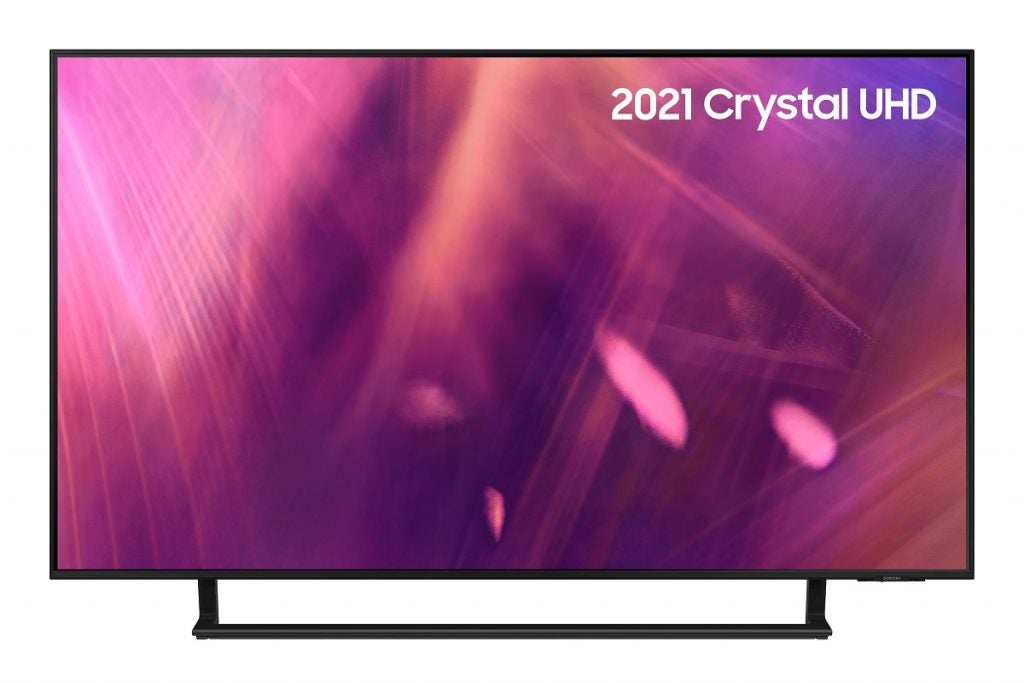
Samsung UE50AU9000
Best budget Samsung TV
Pros
- Impressive 4K picture quality
- Great user interface
- Elegantly slim chassis
Cons
- No Dolby Vision HDR
- Sounds weak and vague
- Upscaling can be exposed on occasion
The UE50AU9000 won our best affordable TV in 2021, and for good reason. Its performance is much better than we’d anticipated and it can still be found for an excellent price.
We found the design especially pleasing, with decent looks alongside a slim depth of 26mm that makes the AU9000 convenient for wall mounting. Assembly of the TV is easy with simple click-in plastic feet and there’s some welcome cable management to help keep the rear area tidy. You will need a wide area to stand it on given the legs are quite far apart.
This is also quite a capable gaming TV for its price, with VRR and ALLM support across the three HDMI inputs, with AMD FreeSync catering for PC gamers who want to use a 4K TV for their gaming sessions. Input lag was measured to be less than 10ms, ensuring a responsive performance whatever you’re playing with game mode on.
Picture quality here impressed, our reviewer found the AU9000 produced detailed and clean looking images alongside deep black tones and good contrast, with colours that looked convincingly natural. We found the backlight to be of decent quality for an affordable set, even if the peak brightness of 350 nits won’t set the world alight for HDR content.
The upscaling performance is confident, even we found some minor issues with how it coped with 480p content, which is not unexpected with most TVs. The AU9000 is a step up above the BU8000 model we tested, which even though it has similar specs, didn’t provide as good a performance.
The audio is quite typical for an affordable set, for or general viewing, it’s going to be fine, but for any serious viewing, we’d advise you to invest in a soundbar.
Reviewer: Simon Lucas
Full Review: Samsung UE50AU9000
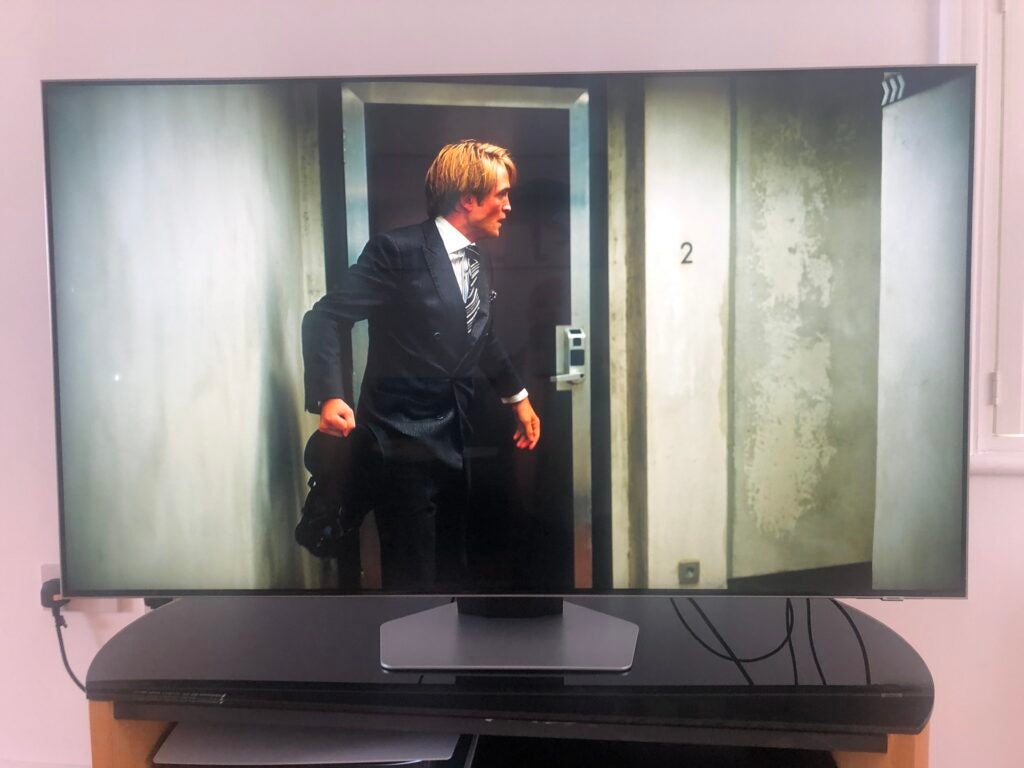
Samsung QE55QN85B
Best affordable Samsung Mini LED TV
Pros
- Bright, vibrant and (mostly) detailed images
- Good spec for next-gen games consoles
- Neat, slim design
Cons
- Struggles to differentiate black tones
- No Dolby Vision HDR (again)
- Smart TV interface has gone backwards
The Samsung QN85B replaces the QN85A, and while its performance is not the slam dunk we would have hoped it would be when we first reviewed. It’s dropped down in price quite significantly, and at its current price we have less misgivings about recommending it.
Like the 2021 model we found this Neo QLED Mini LED offered great peak brightness, noticeable brighter than its OLED and even QD-OLED alternatives. White tones are furnished with plenty of detail and variation in how they appear, it’s at the other end of the spectrum where our reviewer felt the QN85B struggled. Black levels can be at times impressive, but in some circumstances they can lack detail and variation, lacking the type of subtlety OLEDs can deliver in describing brightness down to near-black levels.
Colours, however, are impressively varied and natural in appearance. Upscaling is an aspect of the TV’s performance we found to be solid, suppressing picture noise well and showcasing good edge definition to avoid objects or people looking fuzzy or undefined. Upscaling of content lower than 4K resolution is very accomplished too, we found the processing was well judged and makes watching Blu-rays less of an eye-sore.
There four HDMI inputs support HDMI 2.1 features such as eARC, for hooking up a soundbar if you want to listen to high quality Dolby Atmos and DTS soundtracks, as well as variable refresh rates and 4K 120Hz support.
The audio on this TV is a pretty good effort for a flatscreen, projecting the midrange well, giving clarity to dialogue and creating a decent amount of detail. As we’ve mentioned many times in this list, the OTS system works well to place effects onscreen, though bass is limited. In that respect, for a more cinematic performance we suggest you invest in a dedicated soundbar.
Reviewer: Simon Lucas
Full Review: Samsung QE55QN85B
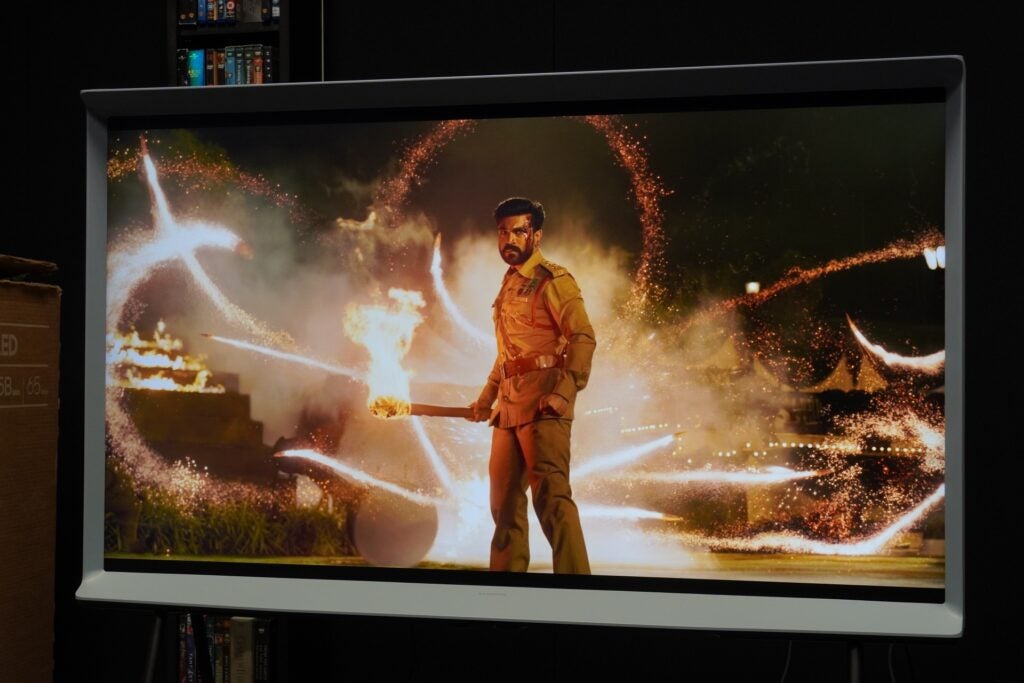
Samsung The Serif
Best Samsung lifestyle TV
Pros
- Distinctive design
- Colourful picture performance
- Good upscaling
- Solid range of smarts
Cons
- Limited HDR performance
- UI can be sluggish
- Not the most practical TV
For years, Samsung has viewed its TV line-up as having as wide an appeal as possible. Thus is created lifestyle TVs for those who want attractive TVs to park into the interiors, and The Serif is very much for those who appreciate design.
It’s a look that will spark conversation, members of the Trusted Reviews had kind and bemused words to say about how it looks, but there’s no doubt The Serif has a very unique look among TVs. Conjured up by designers Ronan and Erwan Bouroullec, it’s both svelte and chunky at the same time. It can be sat on a piece of AV furniture but looks best with the legs attached and freestanding in a room. You could even use its top surface as a shelf to store things on.
It’s up to date with Samsung’s latest smart interface with all the streaming apps accounted for and some gaming action provided in the form of support for cloud gaming. While there’s auto low latency mode, that’s the only concession made to console or PC gamers. You won’t find more advanced features on this set.
The TV’s brightness won’t rival the likes of the QN85B or QN95C at just 367 nits, but for the people this TV is intended for we doubt that will be a big concern. The Serif offers a colourful performance with both HDR and SDR content, with bright yellows and effervescent greens, strong blues and brighter white tones than we observed on a Samsung QN90A Mini LED TV.
It’s also quite capable at upscaling with solid levels of detail and clarity, though we did noticed there’s a yellow tinge given to character’s complexions that givens a slightly unhealthy appearance. Nevertheless, across all sources and resolutions we watched The Serif delivered a colourful performance.
Sound quality is also better than expected with clarity and detail the priority. Bass is decent but modest in size but happily there’s no distortion. It’s also good with music too with vocals presented in a clear and crisp. It won’t beat a dedicated system, which given The Serif’s proportions can be rather hard to connect, but on its own it’s a solid performance.
Reviewer: Kob Monney
Full Review: Samsung The Serif
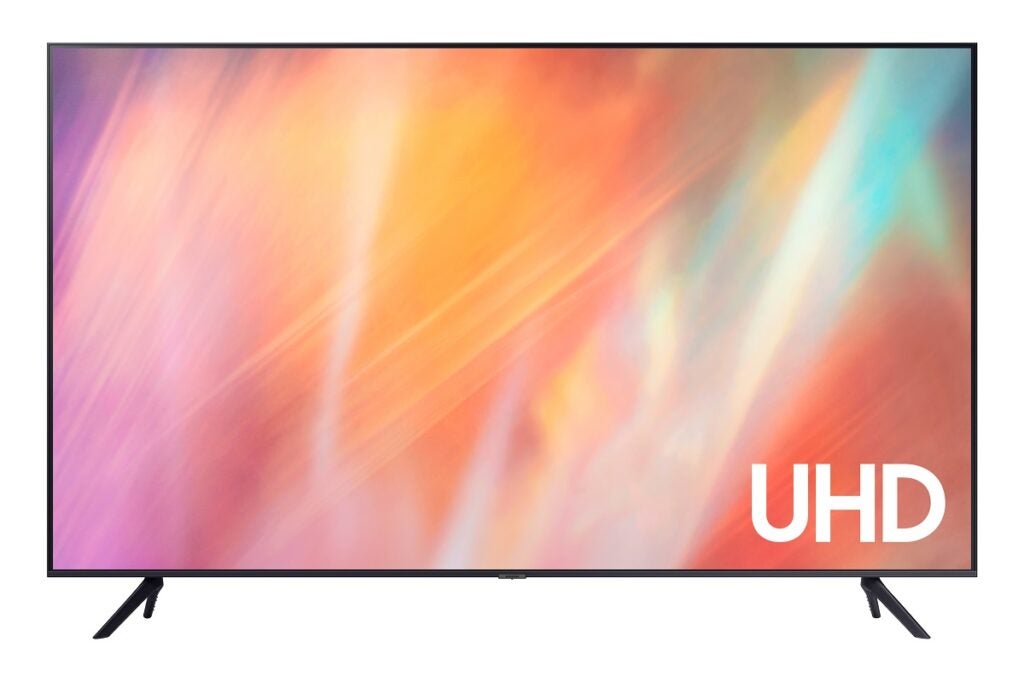
Samsung UE43AU7100
Best small Samsung TV
Pros
- Balanced, believable native 4K images
- Effective smart TV interface
- Good upscaling (up to a point)
Cons
- Contrast suffers from lack of both brightness and blackness
- No Dolby Vision HDR
- Tedious sound
You don’t need loads of cash to get a good viewing experience, and Samsung’s UE43AU7100 makes a good case for small and affordable 4K TVs.
For its sub £400 asking price, we found its performance to be generally good. During testing it retrieved excellent levels of detail for its size, describing faces, textures to intricate patterns in a fine and persuasive manner. Colour reproduction is solid, wide-ranging in tone and convincing natural in their look. Black levels aren’t particularly good, not helped by the lack of overall brightness, the Samsung’s level of detail offers impressive insight into an image but it lacks the ability to truly define black as actual black.
Gaming performance here is ok for a budget TV, although this model lacks VRR support that the Xbox Series consoles and the PS5 can take advantage of. If you are into the gaming, the game mode optimises the UE43AU7100’s performance to reduce input lag for the snappiest experience it can provide.
The design unassuming with its modern and utilitarian looks allowing it to fade into the background, and its small size should help if you don’t have much space for a big TV. We also found it to be rather easy to set up, with a simple series of on-screen prompts to follow for those who hate setting up TVs.
The only big issue here is the audio quality, which is no surprise for a TV of this size. We found the speakers suffice for general viewing, but often sound bland and uninvolving. You’d be better off nabbing an affordable soundbar to go with Samsung’s wallet-friendly screen.
Reviewer: Simon Lucas
Full Review: Samsung UE43AU7100
We also considered…
We’ve reviewed
See all reviewsFAQs
No, Samsung does not support Dolby Vision HDR, instead preferring to support HDR10, HDR10+ and HLG formats.
There’s no support for Freeview Play on Samsung TVs, though all the UK catch-up and on-demand apps are available individually. Samsung offers its TV Plus channels as an alternative to Freeview Play.
Officially, Samsung TVs are not certified for G-Sync gaming. Unofficially, you can play G-Sync compatible games but they will not have been optimised for Samsung’s TVs.




